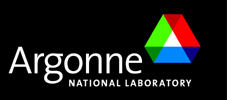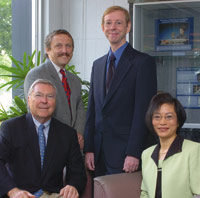 |
Explorer Magazine |
Glass furnaces heating up thanks to new softwareImagine you manufacture window panes. You know you can't sell a window that has a bubble or other defect in it, so every time your industrial furnace produces an imperfect window, you have to recycle the glass and start over. The more you do this, the more money you forfeit in lost productivity. The same problem exists for companies that produce any glass products: bottles, windshields, even computer monitor screens. But now, thanks to award-winning software produced by researchers at Argonne, these companies have a way to ensure their furnaces produce the highest quality glass possible. Argonne's software, called the Glass Furnace Model (GFM), lets manufacturers create virtual furnaces on a computer. Users draw a main chamber, visually add any number of burners and exhausts anywhere into the chamber, and see in three dimensions how the resultant flow of heat circulates into and out of the chamber. In one Argonne study, the GFM suggested slight alterations to a furnace that would improve its efficiency by almost 5 percent. Glass is made in large furnaces in which burners inject fuel and oxidizer (either superheated air or nearly pure oxygen) into the combustion space where they burn, creating temperatures as high as 2400 C. The immense heat melts sand and recycled glass in the chamber, turning it into "liquid glass that flows like cool honey, according to Brian Golchert, technical lead of process simulation and modeling in Argonne's Energy Systems Division. The viscous liquid is then stretched, rolled and manipulated into the desired forms and cooled. But to be effective, a furnace has to do more than just create ultra-hot air. "It's not just the heat going in, but the distribution, Golchert said. "If you put the heat in the wrong place, you can end up with lower quality glass — you get bubbles or grains of sand in the glass. You could have the right amount of energy but in the wrong place. That's why Golchert says the GFM code needs to be run anew for every individual furnace, because each furnace differs based on the products it yields. Different glass products have different densities, viscosities, thermal properties and so on, so each furnace has to be optimized differently to generate the best results. The GFM code was written for the approximately 50 glass-producing companies in the U.S. The GFM can simultaneously model solids, liquids and gases, whereas other models can only represent a single phase at a time. Golchert said making the software easy to use was key. "These engineers are like accountants — they have to keep track of where the matter, the energy, the heat are going, Golchert said. "So we designed it so the engineer doesn't also need a degree in computer science to use the program. As impressive as Golchert says the software is, he admitted he was surprised it won the R&D 100 Award. "I didn't think software would win, but I'm pleased we've been recognized for our work, he said. "I'm only disappointed because [the late] Dr. Shen-Lin Chang, who was instrumental to the success of this program, is not alive to see the award, to see his work and his talents showcased. |
|
|||||||
|
| ||||
|
| ||||
| ||||
